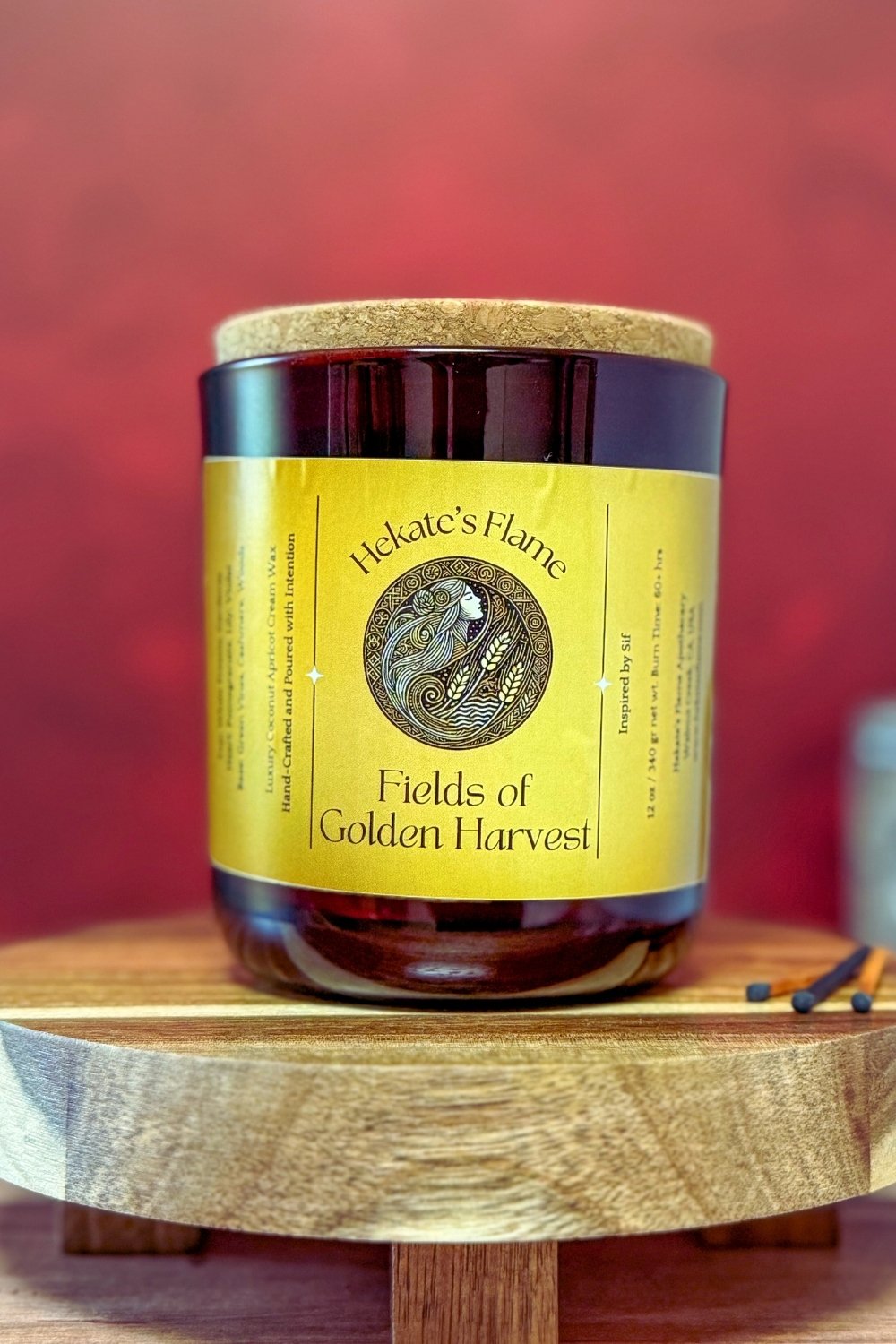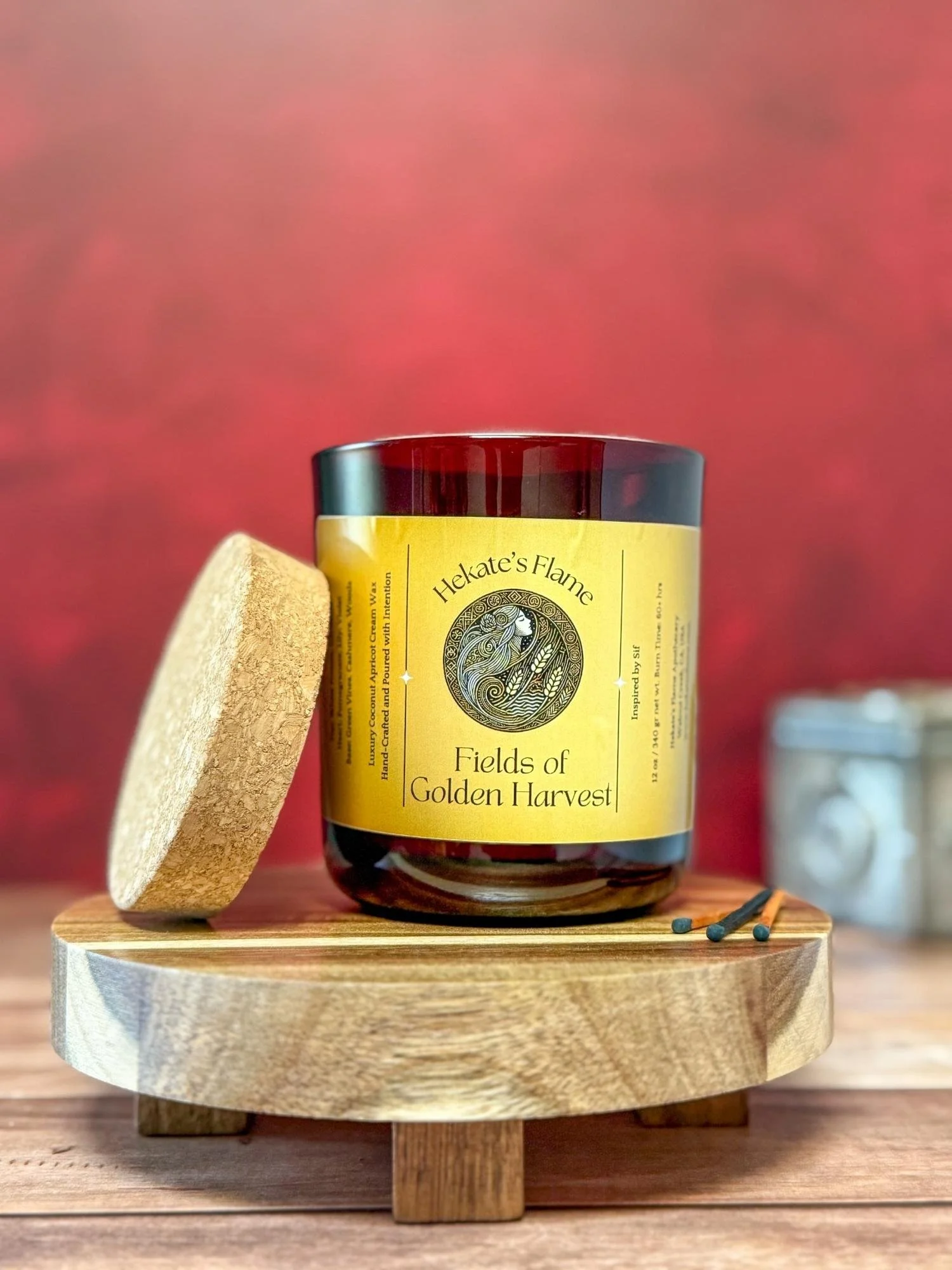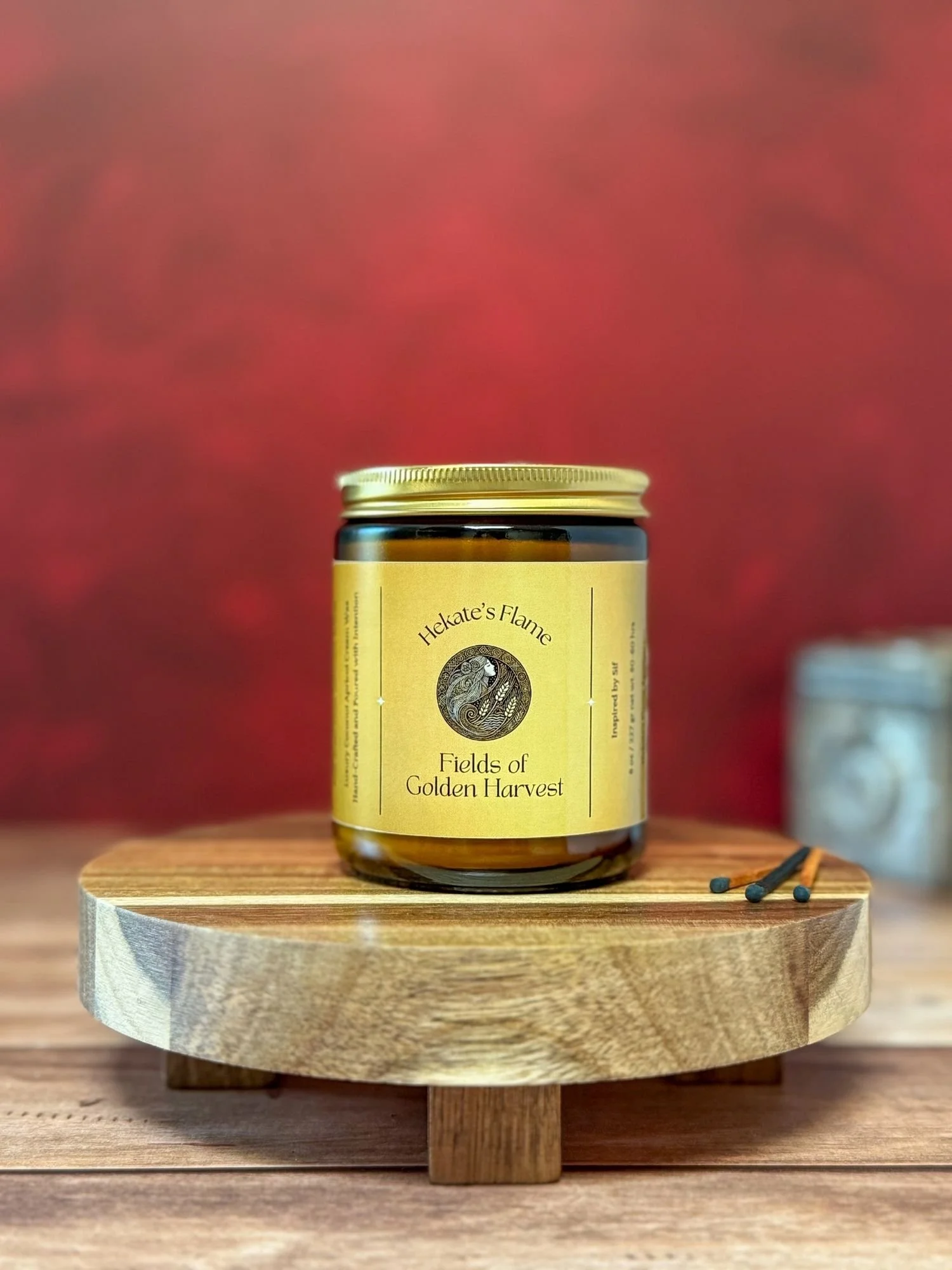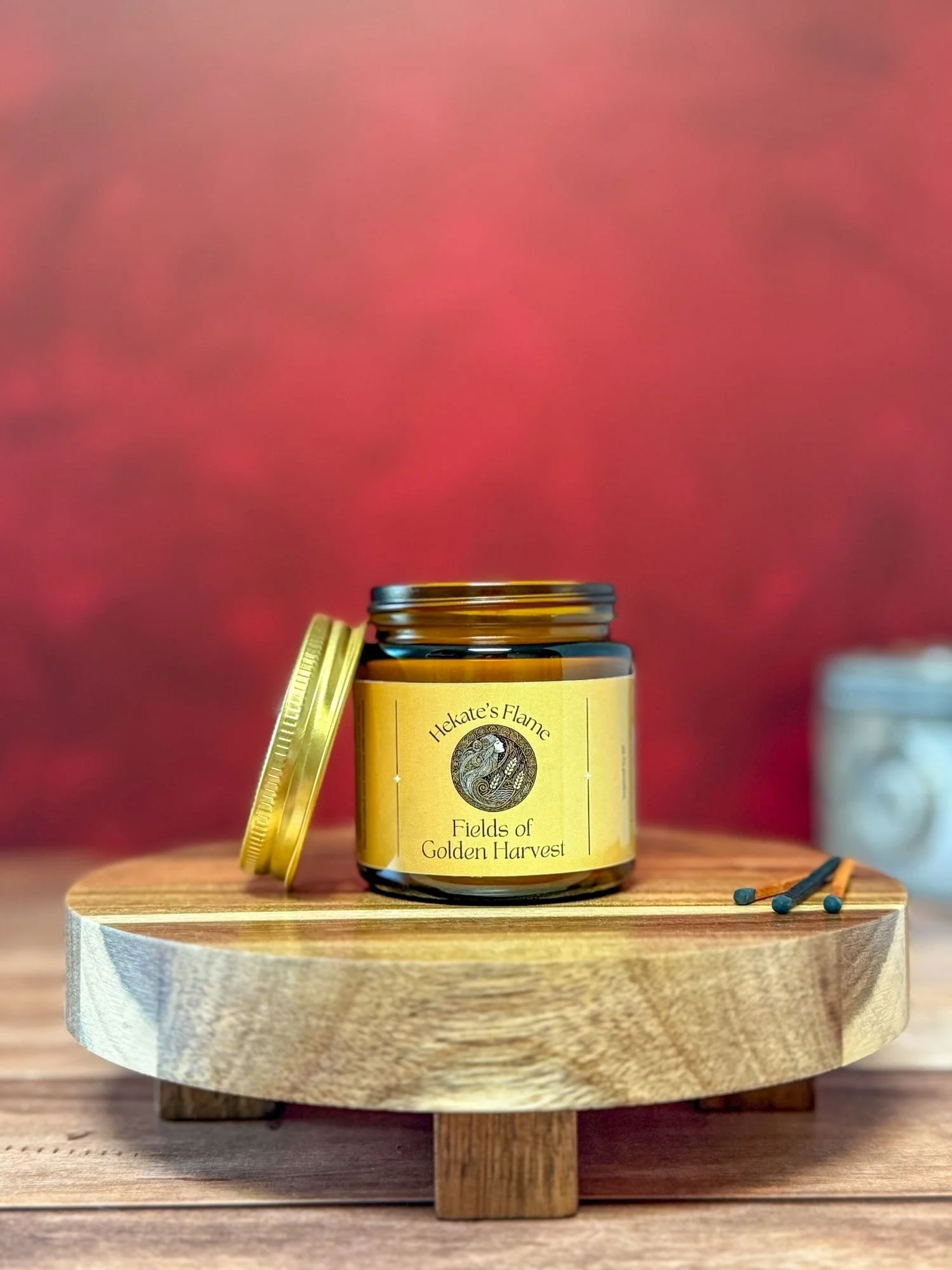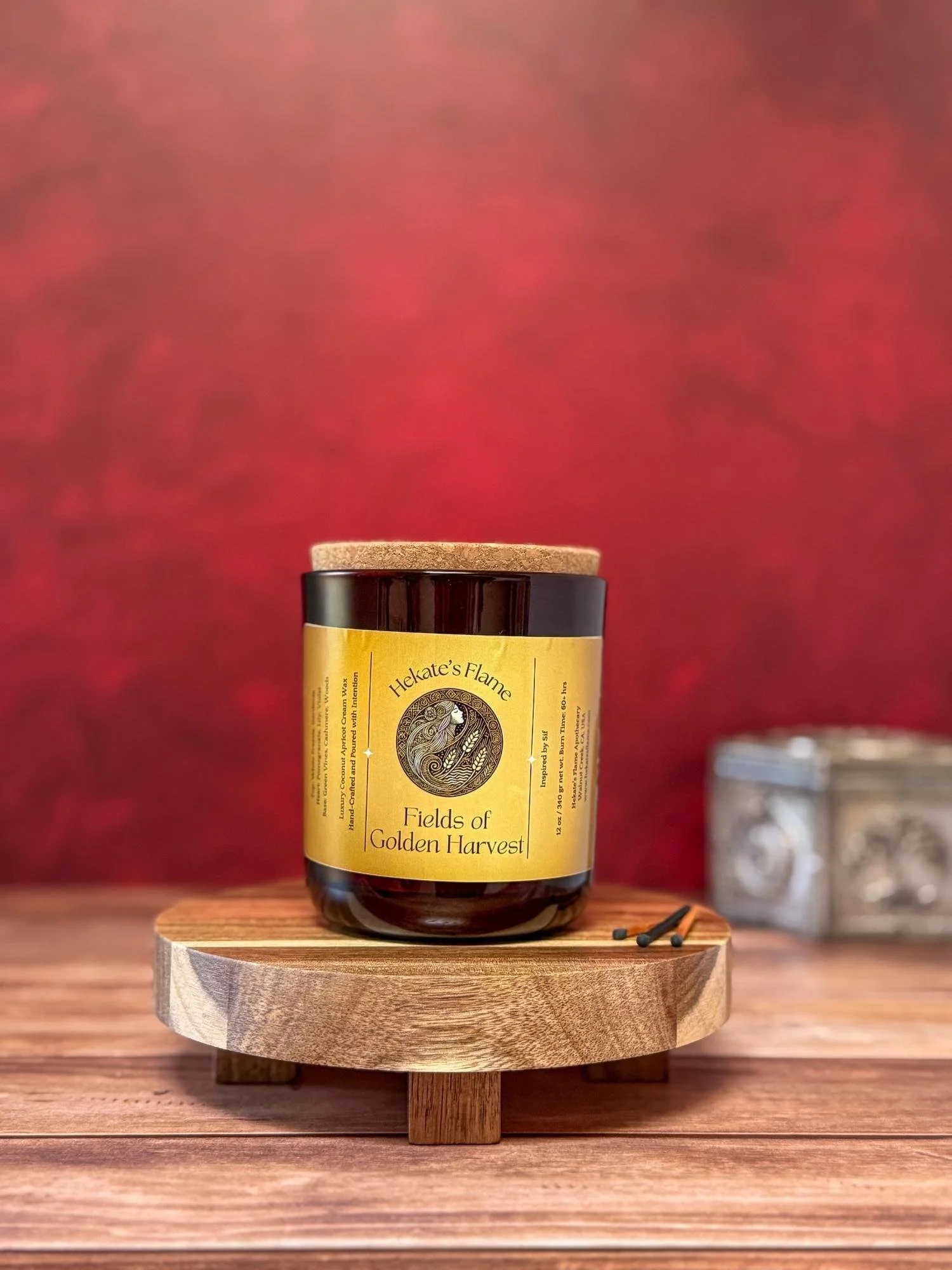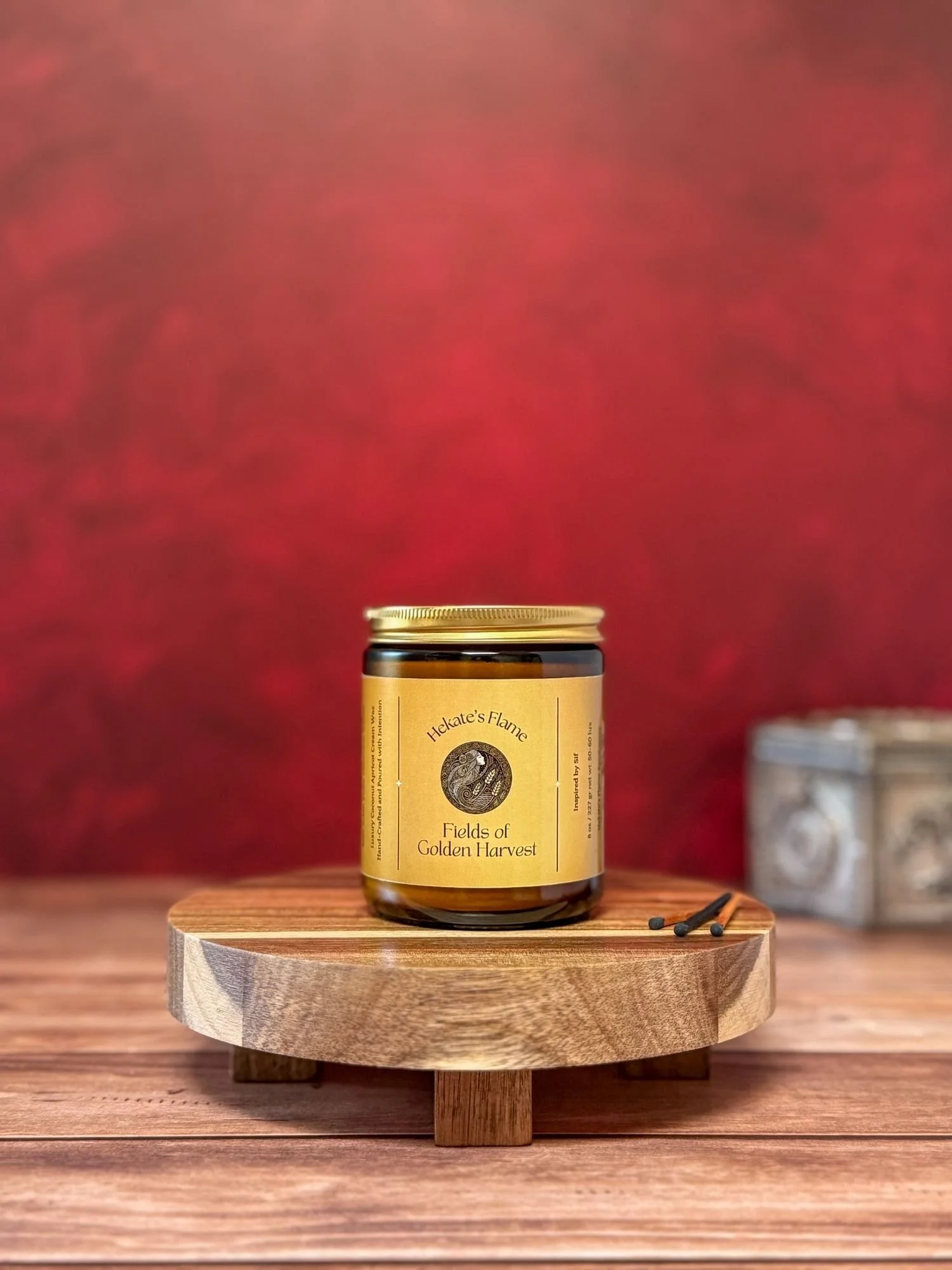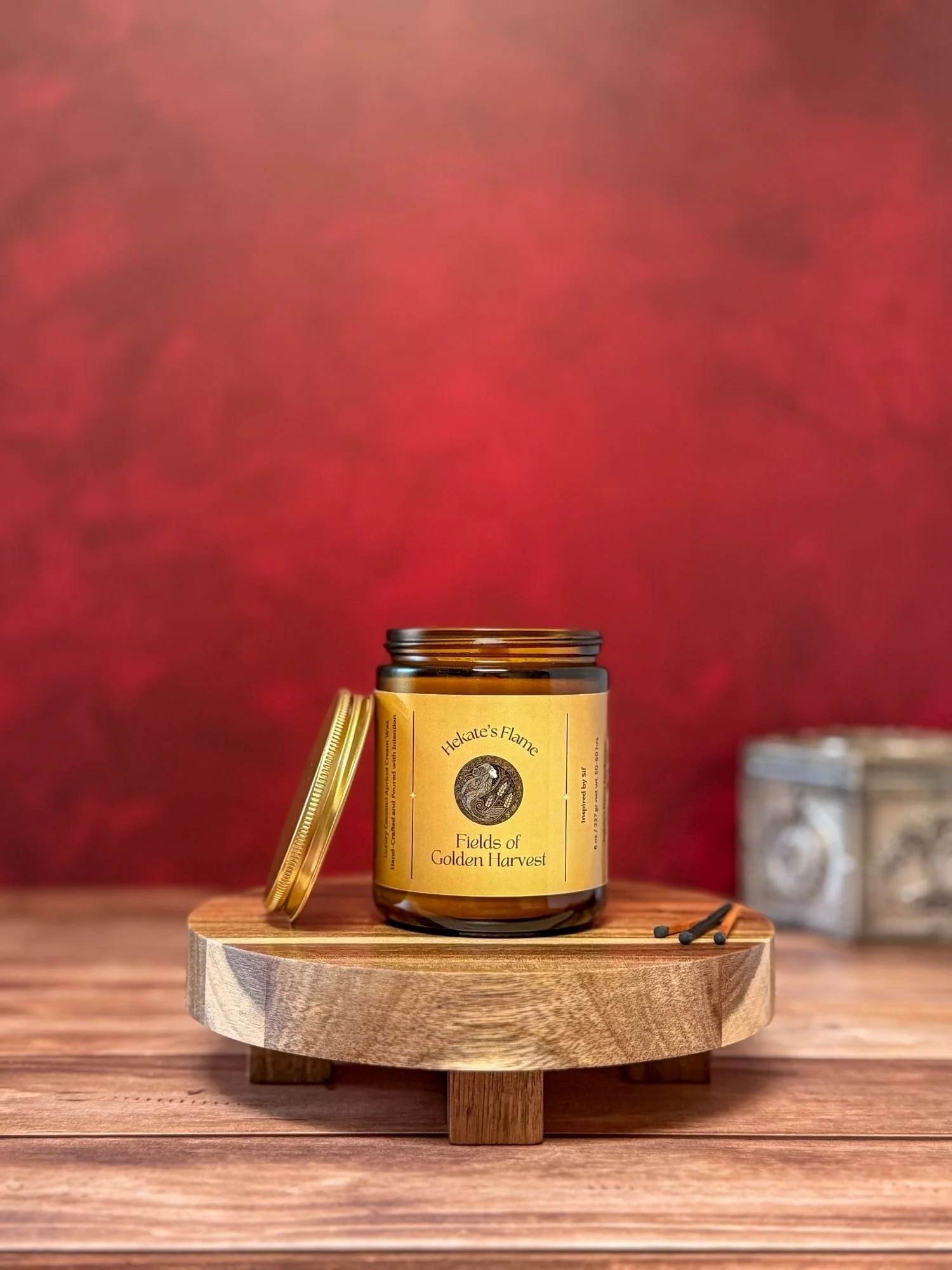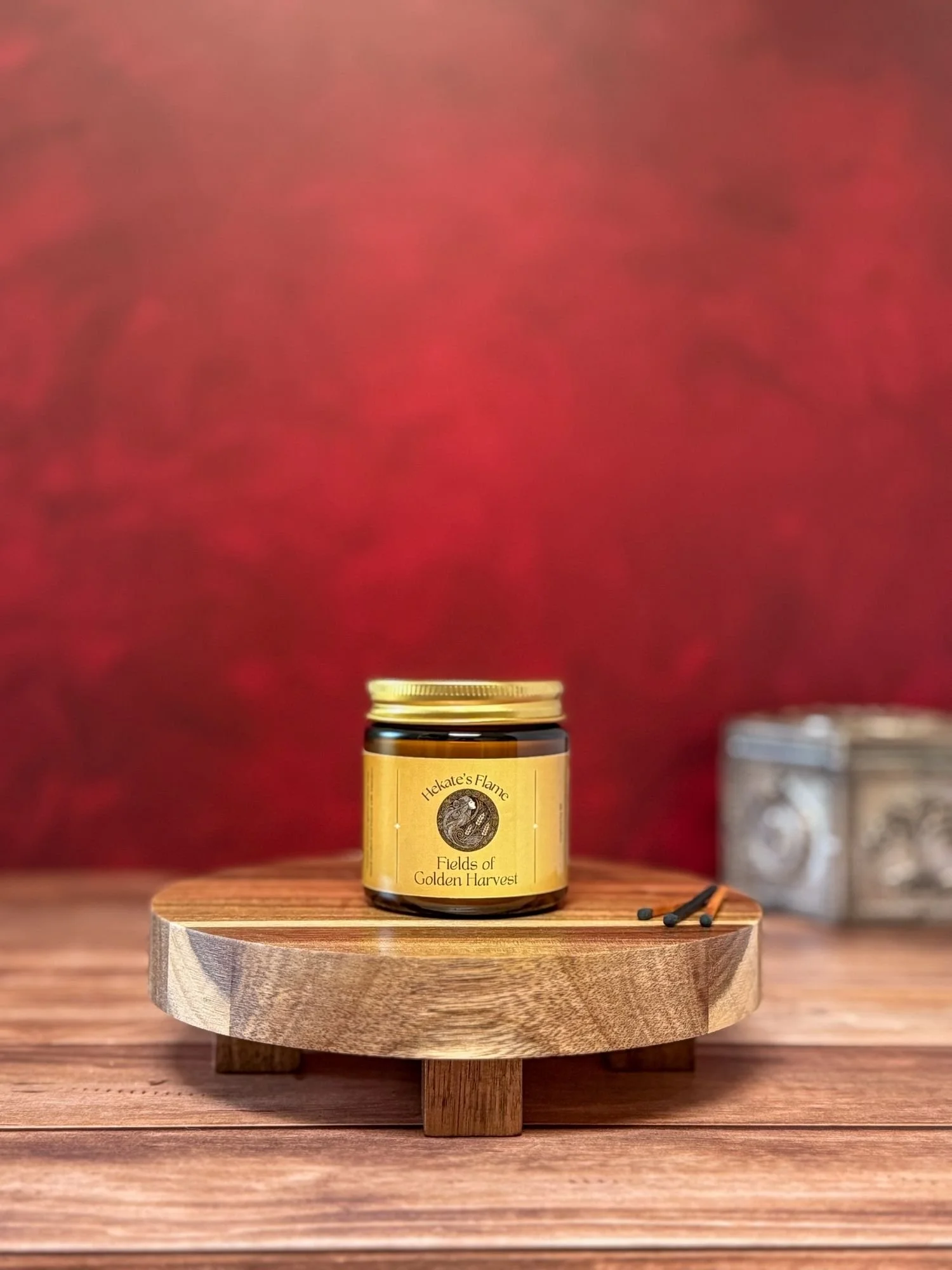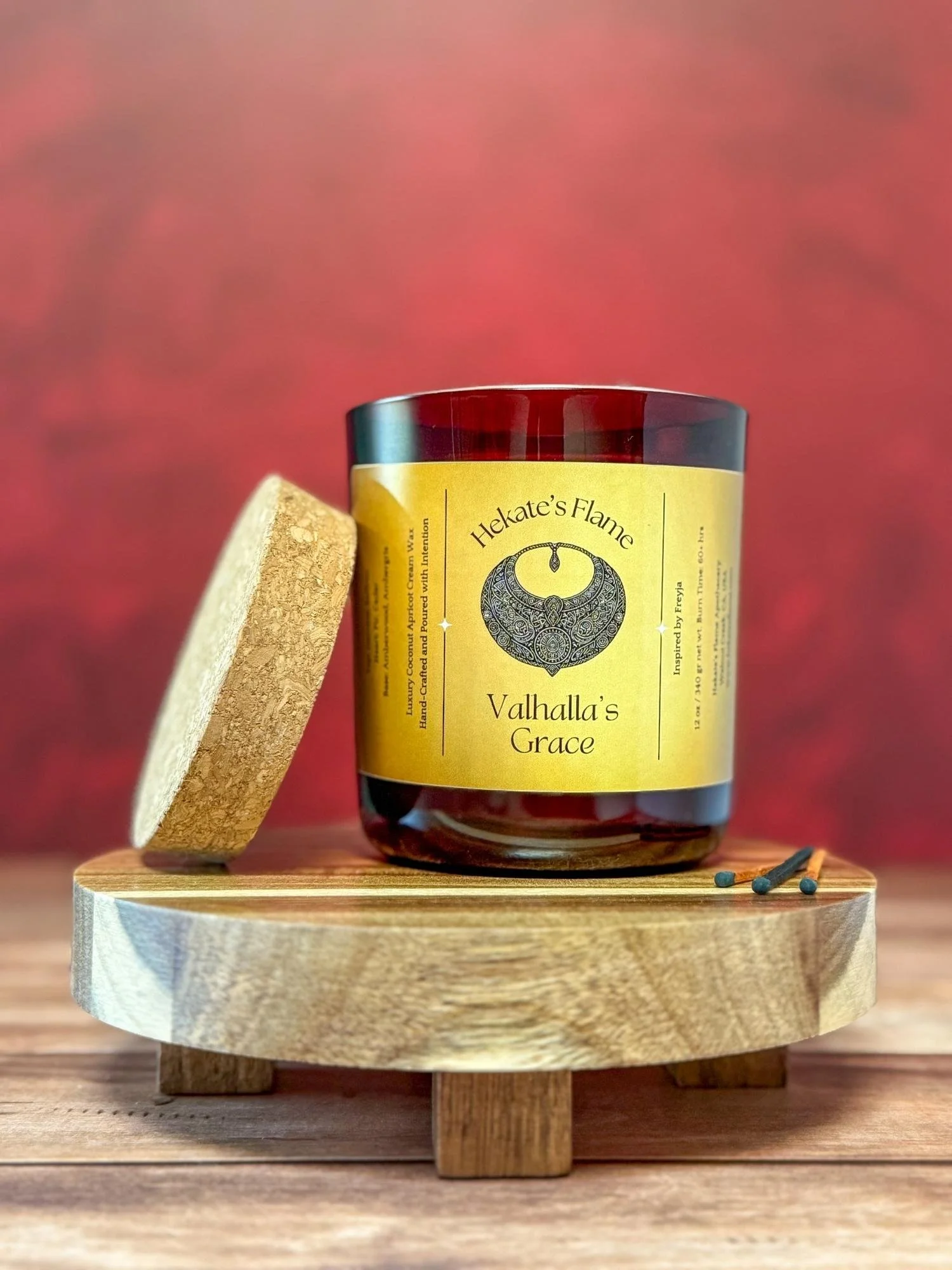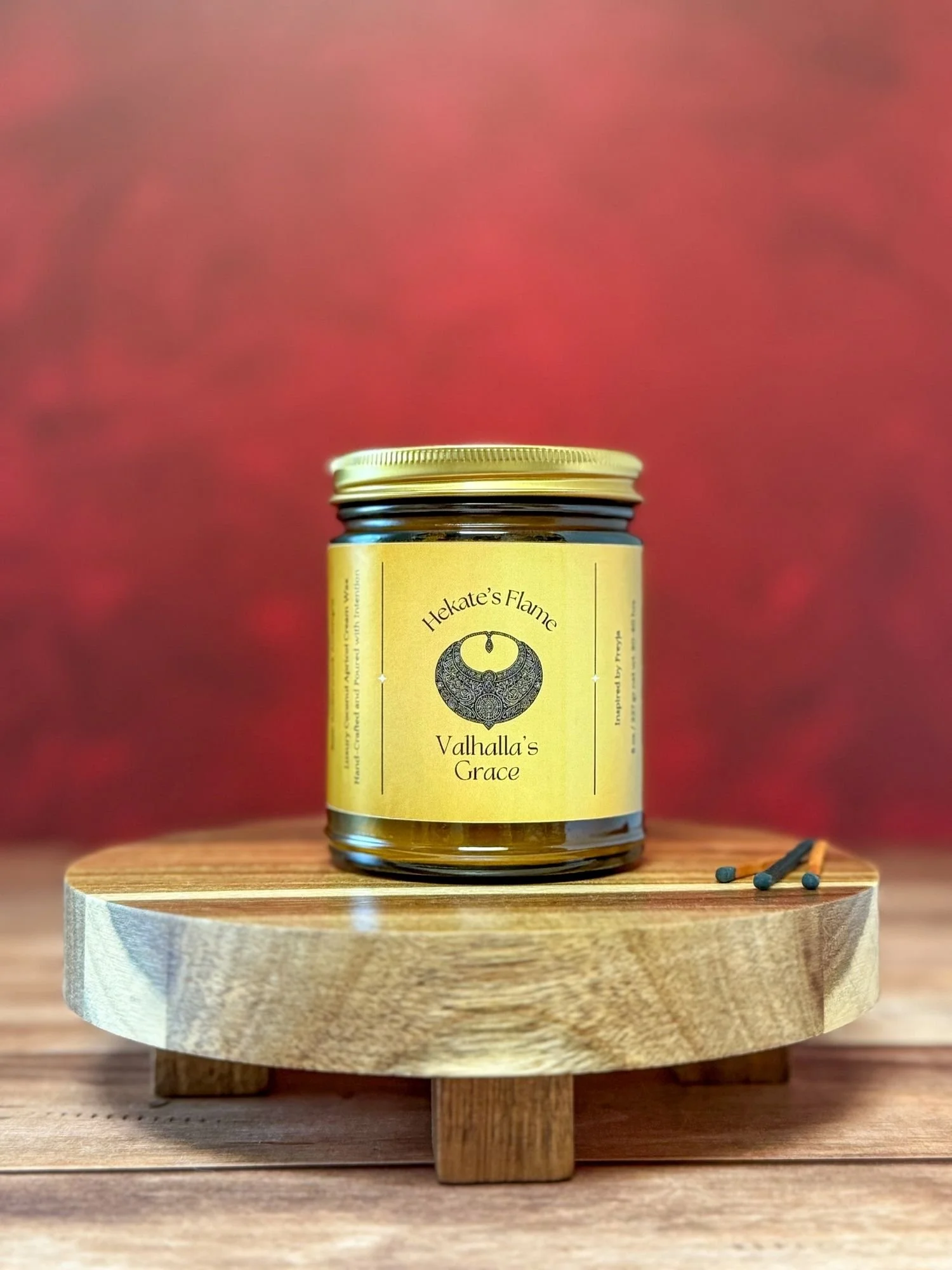‘Fields of Golden Harvest’: a handmade artisanal candle inspired by Sif, the Norse goddess of grain and fertility of the earth
She who weaves the unseen and watches the world from cloud and storm
Imagine standing in a field at dusk, the air golden with dust and sunlight, the earth breathing warmth beneath your feet. That’s the heart of Fields of Golden Harvest: white freesia and gardenia soft as dawn, pomegranate, lily, and violet ripened with color and life, and green vines with cashmere woods grounding it all in quiet strength. A scent of abundance and renewal, a tribute to Sif’s golden grace and the steadfast rhythm of the land.
Scent Notes:
Top: White Freesia, Gardenia
Heart: Pomegranate, Lily, Violet
Base: Green Vines, Cashmere, Woods
🍂 Season Scent: Autumn
🌸 Primary Scent Family: Floral
🌿 Secondary Scent Family: Woody & Earthy
Please visit this blog post for more information on Scent Profiles, Top, Heart, and Base Notes.
Our candles are lovingly handcrafted in our home studio, Nimue’s Lair, nestled in Walnut Creek, CA. Each one begins with a luxurious blend of coconut-apricot wax, carefully infused with premium fragrance oils. Poured by hand into elegant glass vessels and amber jars, they’re finished with hand-cut labels and enchanted final touches. Every candle is a small ritual, infused with magick, intention, and the quiet glow of story.
-
12 oz Deluxe – Wine Red Aura Glass · Coco Apricot Wax
Burn Time: 60+ hours
Bold and enduring, this candle fills your space with myth and memory. Crafted for spacious sanctuaries, this candle shines in wide-open living rooms, high-ceilinged studios, and sacred hearths ~ places where scent is free to roam and the flame becomes a luminous companion to stillness and story.8 oz Classic – Amber Jar · Coco Apricot Wax
Burn Time: 50–60 hours
A perfect size for quiet corners and thoughtful pauses. Let it warm your reading nook, home office, or bedside altar, where its flame flickers like a whisper of intention.4 oz Petite – Amber Jar · Coco Apricot Wax
Burn Time: 20–25 hours
Small in size, rich in presence. This candle is ideal for travel, gifting, or sanctifying intimate spaces - guest rooms, personal altars, or quiet corners where scent and flame are invited to linger with intention. -
For detailed information about our waxes, wicks, fragrance blends, and vessels, please see our Ingredients & Materials Guide.
-
For guidance on how to tend your flame with care, ensuring the cleanest, safest, and most enchanting burn, please visit our Candle Care Guide.
-
Please visit the Shipping and Returns Information page for details.
-
All photographs, images, and written content on this website are original works of Hekate's Torch Apothecary, LLC (doing business as Hekate’s Flame Apothecary) and are protected by copyright. They may not be used, altered, shared, or reposted on any platform without explicit written consent. All label designs, photos, images, and content are the exclusive property of Hekate's Torch Apothecary, LLC.
For inquiries regarding the use of our content, please contact: care@hekatesflame.com
© 2025 Hekate's Torch Apothecary, LLC. All rights reserved.
Content Warning:
This post explores ancient myths that include themes of violence, including assault and warfare, which may be sensitive for some readers. Please proceed with care and be mindful of your well-being while engaging with these stories.
Sif, the Golden-Haired Goddess of Norse Mythology: Fertility, Family, and Endurance
In Norse mythology, where tales of gods and giants, heroes and monsters dominate the tales of an ancient world, there is a figure both luminous and elusive. Sif, the golden-haired goddess, is often overshadowed by the more famed deities of Ásgard: her husband, the thunder-wielding Thor, or her kin, the powerful Frigg and Freyja. Yet, Sif's quiet presence whispers of ancient mysteries, of lost rites and almost-forgotten roles. Her golden hair, shimmering like fields of ripe grain, has inspired tales and poetic kennings, evoking the fertility of the earth and the cycles of growth and harvest.
Some see Sif as a fertility goddess, an embodiment of the earth's abundance. In contrast, others view her as a mere figure in the shadow of Thor, significant only for her marriage. But perhaps Sif's story holds more than meets the eye ~ a tale of a once-mighty goddess whose true influence has faded with the passing centuries. As we unfold her myths, symbols, and associations, we explore an ancient figure whose beauty and mystery remain undiminished, even as her tale lies scattered like autumn leaves across Norse lore.
Origins and Etymology of Sif's Name
The name "Sif" carries the resonance of relationships, denoting a connection bound not by blood but by marriage. Derived from Old Norse, her name translates to "relation by marriage" or simply "wife." In this, Sif's identity is tethered to kinship and family, a theme that would follow her across Norse mythology. Her role as Thor's wife and mother to his children places her firmly within the intimate sphere of home and hearth, embodying ideals of loyalty, connection, and union.
However, scholars have long speculated that Sif's true nature may extend beyond her marriage to Thor. The sparse records of her mythology suggest a deity who was once more prominent, whose role perhaps predates the thunder god's rise to prominence. Her golden hair, so vividly described in Norse poetry, hints at ties to the earth's cycles, fertility, and the harvest, suggesting that Sif may once have stood as an emblem of the land's vitality. And yet, by the time her myths were recorded, this legacy had faded, leaving only fragments for us to piece together.
Sif as a Symbol of Fertility and the Earth's Abundance
Understanding Sif as a goddess of fertility means looking beyond the written record and into the symbolic associations surrounding her. In ancient mythologies, the divine union of a sky god and an earth goddess often represented the generative power that brought life to the world.
Sif and Thor's relationship can be seen as a form of hieros gamos, or sacred marriage, an archetypal union where Thor's rains and thunder fertilize Sif, who embodies the fertile earth. This connection symbolizes the life-bringing forces of nature and the harmonious cycles essential for human survival. With her golden locks, Sif becomes an emblem of the land itself, abundant and ready to be sown, while Thor's thunderous might provides the rains that nourish her.
Among the Sámi, an Indigenous people native to the northern regions of Europe, including Norway, Sweden, Finland, and the Kola Peninsula in Russia, Sif's identity is closely entwined with the rowan tree, a lasting symbol of growth and protection. Known as "Thor's savior" in some Norse myths, the rowan tree was revered for its beauty and its reputed ability to ward off evil, shield homes, and provide safety for travelers. This sacred connection between Sif and the rowan further reinforces her role as a goddess of nurturing and resilience. Her link to the rowan serves as a living emblem of the earth's cycles and highlights the belief that Sif herself embodies the protective, regenerative qualities of nature.
Sif's hair, often likened to rippling fields of wheat, is more than a symbol of beauty; it's an emblem of the harvest, the lifeblood of agrarian societies. As the seasons turned, Norse farmers would look to the skies and the soil, relying on the sacred union of rain and earth to sustain them. It's no wonder that Sif's hair came to represent prosperity, her golden tresses mirroring the waves of grain that would feed families through the long winters.
Yet, unlike other fertility goddesses like Freyja or Frigg, Sif never had temples, nor does any record show her as the center of a specific cult or ritual. This has led some scholars, like Rudolf Simek, to suggest that Sif's connection to fertility might be a later interpretation, perhaps woven into her story by Christian scribes who sought to preserve fragments of a vanishing pagan culture. In this view, Sif's connection to the earth is subtle, hinted at in kennings and poetic descriptions rather than stated outright.
The Myth of Sif's Golden Hair: Mischief, Creation, and Divine Treasures
In Norse mythology, few tales capture the spirit of mischief and cosmic creativity, like the story of Sif's golden hair. This story finds its most detailed telling in the "Skáldskaparmál" section of the Prose Edda, where Sif's crowning beauty and vitality are highlighted, and the roles of both Loki and Thor in her transformation are vividly recounted. The tale begins in the silent halls of Ásgard, under a sky thick with stars. As Sif lay sleeping, her golden locks flowed around her like rivers of sunlight, a crowning glory that embodied beauty and vitality. Her hair was more than mere adornment; it symbolized abundance, growth, and the earth's harvest ~ a radiant reminder of the cycles that sustained life.
The trickster Loki, however, saw in Sif's beauty an opportunity for amusement. Slipping through the shadows, he crept into her bedchamber and, with a blade as sharp as his cunning, severed her golden tresses in one swift stroke. This act of mischief serves as the catalyst for a cascade of events detailed by Snorri Sturluson, the Icelandic mythographer, in the Prose Edda, whose work remains one of the few comprehensive records of Sif's tale. When dawn arrived, Thor awoke to find his wife's once-glorious hair reduced to stubble, her pride and beauty diminished by Loki's careless whim.
In the "Prologue to the Prose Edda," Sif's relationship with Thor and the reverence her beauty commanded among the gods positions her as a dignified figure, underscoring the gravity of Loki's violation.
Thor's rage was a storm in itself. The halls of the gods echoed with his fury as he hunted down Loki, his wrath as relentless as thunder. Cornered and desperate to save himself, Loki pleaded for mercy, swearing he would make amends. He vowed to replace Sif's hair with something even more magnificent forged by the greatest craftsmen in all the realms.
Descending into the depths of Svartalfheim, Loki sought the sons of Ivaldi, the legendary dwarven smiths. With a challenge as tempting as it was impossible, he commissioned them to craft a headpiece of gold as fine and lifelike as Sif's original hair. The dwarves set to work, their hammers ringing out in the dark, fiery depths, shaping strands of pure gold that gleamed with an ethereal light. This was no ordinary headdress. When placed upon Sif's head, the golden locks would take root and grow as alive as her own hair.
But Loki, ever the gambler, could not resist a further wager. Taunting the dwarf brothers Brokkr and Sindri, he bet his head that they could not create treasures to rival the beauty of Sif's new hair. Rising to the challenge, Brokkr and Sindri began their work, conjuring five legendary artifacts that would become the prized possessions of the gods. They forged Mjölnir, Thor's indomitable hammer that could summon lightning and return to his hand; Gungnir, Odin's spear that never missed; Skidbladnir, a ship that could fold small enough to fit in a pocket; Draupnir, Odin's ring that multiplied itself every ninth night; and Gullinbursti, the golden boar, whose light rivaled the sun.
When Loki returned to Ásgard, he presented these treasures to the gods, restoring Sif's beauty with a head of golden hair more brilliant than before. Her new hair became a living symbol of renewal, shimmering with the promise of harvest and prosperity. Though Loki's mischief had brought chaos, it also led to creation, leaving Ásgard with gifts that would alter the fates of gods and men alike.
Through this tale, recorded with great poetic detail in the Prose Edda, Sif becomes more than a victim of Loki's trickery; she becomes the catalyst for transformation and creativity. Her beauty and dignity inspire acts of creation that resonate through the myths of the Norse. Sif's golden hair, reborn and enhanced, stands as a testament to resilience and renewal, a symbol of life's enduring cycles, even in the face of loss.
Sif as the Peacemaker: Embodiment of Family, Unity, and Diplomacy in Norse Mythology
In Norse mythology, where thunderous gods and fierce giants clashed, Sif stood out as a quieter yet profound force of harmony and unity. Known for her golden hair that shimmered like ripe fields of grain, Sif embodied the essence of fertility and the sustaining power of the earth. Yet, her significance extended far beyond these realms. As Thor's wife, she represented the ideals of family and kinship. As a goddess, she wielded a gentle diplomacy that held the divine community together, echoing Norse values of unity and resilience.
In the ancient Norse world, family and clan formed the backbone of survival. Sif's name, translating to "relation by marriage," reflects her role as a unifying force, both in her marriage to Thor and in her influence among the gods. Her presence was a quiet, stabilizing element, embodying the strength of kinship that linked communities and held them together through hardship. Some scholars even see parallels between Sif and figures like Wealhþeow (Wealhtheow), the queen in Beowulf, who served as a peacekeeper and diplomat within her court. Such comparisons suggest that Sif's influence might have extended beyond Norse lore, inspiring depictions of feminine grace and diplomacy across cultures.
Challenges from powerful foes tested the bonds of Sif's family. In one myth, Hrungnir, a giant of great strength and arrogance, brazenly claimed Sif as his prize. He threatened to abduct her, along with Freyja, and to carry Valhalla itself back to Jötunheim.
Though ultimately thwarted by the gods, Hrungnir's actions underscored Sif's value within the divine community, emphasizing her status and the protective bonds of her family. Her quiet strength, often overshadowed by Thor's heroic exploits, lay in her role as a binding force, a figure around whom the divine household could gather in unity and trust.
Even amid divine discord, Sif emerged as the embodiment of peace. In Lokasenna, also known as "The Taunts of Loki," her role as a peacemaker shines through vividly. When Loki, the trickster, disrupts a grand feast with insults and accusations, sowing discord among the gods, it is Sif who steps forward with a calming gesture. Offering Loki a horn of mead, she seeks to defuse the brewing tension with a gesture of goodwill, embodying the Norse ideal of hospitality and the sacredness of shared meals. Her calm and dignified response is a reminder that even those who disrupt the social order can be met with grace and that peace can be offered even to those who threaten it.
In this moment, Sif speaks in measured words:
"Hail to you, now, Loki.
Take this drink I offer you
of our good old mead.
Do this, rather than find fault
with me, alone among
all the gods and goddesses."
Her words underscore the values of civility and kinship that held great significance in Norse society. Conflicts within or between kin groups could unravel communities, making the ability to mediate and maintain unity a cherished ideal. Sif's response to Loki reflects her enduring strength, a quiet resilience that holds its ground without rising to provocation. Even as Loki responds with a biting accusation, taunting her with claims of infidelity, Sif remains composed, embodying a stoic dignity that sets her apart among the gods.
Her role as the "goddess of breaking bread" represents more than family gatherings; it symbolizes the deep alliances that Norse communities depended on for survival. Gatherings around the hearth, laughter shared at feasts, and the bonds forged in shared meals were all essential to the strength of kin networks. Sif's presence among the Æsir reaffirmed these values, reinforcing the sacredness of family and community ties that were critical in a world fraught with challenges.
Another tale underscores the ongoing threats faced by Sif's family, highlighting her role as a resilient figure within Norse mythology. Hrungnir, the same giant who once threatened to claim her, later targeted her daughter Thrud. While details of Thrud's abduction remain scarce, Hrungnir's pursuit reflects the persistent hostility between giants and the Æsir, with Sif and her family standing as symbols of resilience and unity in the face of turmoil.
Through these stories, Sif is portrayed not only as a symbol of family and fertility but as a protector of peace and social bonds, a role that aligns with her associations with unity and community. In a society where survival often depended on cooperation, Sif's presence reinforces the Norse values of loyalty, respect, and the quiet strength of kinship. For modern Heathens and followers of Norse traditions, Sif remains a figure of diplomacy and social civility, an ideal that values harmony and strives to keep conflicts at bay. Her legacy as a peacemaker speaks to the power of gentleness and the enduring bonds of family, a testament to the sacred role of unity within the Norse pantheon.
Sif as a Lost Goddess: Echoes of an Ancient Deity
The enigmatic nature of Sif's mythology has led scholars to ponder whether she might be a remnant of an older, pre-Christian goddess whose significance has been largely erased. In early skaldic poetry, fleeting references to Sif suggest she may have held a more prominent role in ancient belief systems. Her golden hair, the symbol of harvest and prosperity, and her association with kinship could indicate that she was once a deity revered in her own right, perhaps even predating the Aesir.
Comparative mythology draws intriguing parallels between Sif and other goddesses associated with the earth and fertility. Some scholars connect her to the Greek goddess Demeter. Like Demeter, Sif seems to embody the cyclical nature of life, death, and renewal, but unlike Demeter, she lacks a defined cult or mythic narrative centered solely on her.
Rudolf Simek and others have argued that Sif's identity was diluted over time, her characteristics absorbed by goddesses like Freyja and Frigg. The fact that Sif's name translates to "relation by marriage" suggests that her role may have been reinterpreted to emphasize her connection to Thor rather than her individual identity. It is possible that, as the Norse pantheon evolved, Sif's original functions as a goddess of fertility and the earth were eclipsed by more prominent figures.
Yet, even with her diminished role, Sif remains a figure of intrigue, a reminder of a forgotten past. The image of her golden hair, shimmering like fields of grain, hints at a deep, ancient reverence for the cycles of nature, for the bounteous gifts of the earth. In exploring Sif's character, we find echoes of an older world where her presence was perhaps as significant as Thor's thunder and Odin's wisdom.
Symbols and Iconography: The Golden Hair of Sif as a Metaphor for Harvest and Renewal
Sif's golden hair is perhaps her most iconic feature, a physical manifestation of her connection to the earth's abundance and the cyclical nature of life. In Norse poetry, her hair is likened to flowing fields of wheat, a visual that captures the essence of harvest and fertility. The kenning "Sif's hair" became a poetic synonym for gold, and this association permeated Norse culture, emphasizing the value of both the goddess and the precious metal.
Beyond her hair, Sif's symbols include wheat, fields, autumn leaves, and even the rowan tree. Modern followers of Norse paganism see Sif as a goddess of harvest, family, and abundance, honoring her for her mythic beauty and the deeper meanings embedded in her image. In a world that depended on the harvest to survive, the symbolism of Sif's golden hair would have been a powerful reminder of the earth's blessings.
Sif in Comparative Mythology: Parallels Across Cultures
Sif's portrayal as an earth goddess aligns her with figures across various mythologies, from Demeter in Greek tradition to Ceres in Roman lore. These goddesses, like Sif, embody the nurturing aspects of the earth and are intimately tied to the cycles of agriculture. In comparing Sif with Demeter, we find parallels in myths of loss and renewal, where Demeter's grief at the abduction of her daughter Persephone brings winter upon the land, Sif's golden hair, cut by Loki, represents a similar motif of restoration and the cyclical renewal of nature. In comparing Sif with these figures, we see the universality of certain archetypes—the earth goddess as a figure of renewal, sustenance, and family.
The role of a "lost goddess" is not unique to Sif; many ancient deities faded into obscurity or had their roles diminished as cultures evolved and adopted new religious frameworks. Sif's possible transformation from a central fertility figure to a supporting character in Thor's mythology mirrors the fate of countless goddesses whose worship was subsumed by patriarchal structures or eventually forgotten. For instance, Anat, the fierce Canaanite goddess of war and fertility, lost prominence as her attributes merged with later goddesses like Astarte. Similarly, Tefnut, an Egyptian deity associated with rain and fertility, saw her worship wane as male deities like Ra and Horus took precedence. Greek mythology offers another example in Rhea, the Titaness mother of the Olympian gods, whose worship diminished as her roles passed on to her children, especially to Demeter, in her association with the earth and fertility.
This pattern of once-powerful goddesses becoming supporting figures can be seen across diverse cultures. In Celtic mythology, the Morrígan, originally a formidable goddess of war and sovereignty, eventually became more mythic than worshipped, with some of her attributes carried over into Christianized figures like Saint Brigid.
Ereshkigal, the Sumerian and Akkadian queen of the underworld, faced a similar fate as her sovereignty was overshadowed by male gods like Nergal, later portrayed as her consort. Sif's legacy thus echoes a broader tradition where the importance of goddesses central to life, death, and renewal cycles was gradually reduced in favor of male counterparts, leaving only traces of their original influence in myths and symbols.
Rediscovering Sif, the Forgotten Goddess of Abundance and Kinship
Sif's presence in Norse mythology may be understated, but her legacy is rich with meaning. As we peel back the layers of her story, we uncover a goddess who embodies the strength of family, the power of abundance, and the quiet dignity of peace. Whether she was once a more prominent fertility deity or simply a symbolic figure tied to Thor, Sif's image, her golden hair flowing like waves of wheat, remains a powerful symbol of the cycles of life, growth, and renewal.
Yet, in reflecting on Sif's story, we also witness the subtle reshaping of myth as cultures evolved. The arrival of Thor, with his thunderous authority, marked a shift in Norse mythology that often relegated goddesses like Sif to quieter roles. As patriarchal frameworks took hold, figures who once held powerful, autonomous positions as symbols of the earth's rhythms and abundance saw their narratives gradually eclipsed. This phenomenon, of a goddess fading from central worship to supportive presence, mirrors the broader pattern in which once-revered feminine archetypes were subsumed under patriarchal hierarchies, altering the shape of their worship and legacy.
In exploring Sif's mythology, we glimpse a connection to a lost world where nature's cycles were revered and where kinship and community were vital to survival. Sif's story, her symbols, and her role as a potential "lost goddess" invite us to reflect on the values she represents: harmony, resilience, and the enduring bonds of family. Though her myths may be fewer than those of her counterparts, Sif's legacy is a testament to life's quieter, sustaining forces that resist erasure. Her story invites us to remember not only the goddess herself but also the cultural shifts that reshaped her, offering insight into the evolution of myth and the enduring value of the cycles of nature and human connection.
References:
Cavendish, R. (1970). Man, myth and magic: an illustrated encyclopedia of the supernatural. Marshall Cavendish Corporation.
Illes, J. (2010). Encyclopedia of spirits: The ultimate guide to the magic of fairies, genies, demons, ghosts, gods & goddesses. Harper Collins.
Littleton, C. S. (2002). Mythology: the illustrated anthology of world myth & storytelling. Duncan Baird.
Mark, J. J. (2021, September 7). Sif. World History Encyclopedia. https://www.worldhistory.org/Sif/
McCoy, D. (n.d.). Sif. Norse Mythology for Smart People. https://norse-mythology.org/sif/
McCoy, D. (2016). The Viking spirit: An introduction to Norse mythology and religion. CreateSpace Independent Publishing Platform.
Then Sif came forward and poured mead for Loki in a crystal cup, and said:
“Hail too thee, Loki, and take thou here
The crystal cup of old mead;
For me at least, alone of the gods,
Blameless thou knowest to be.”

